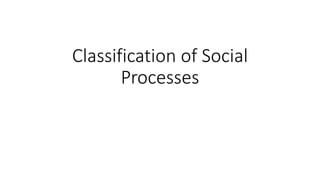
SOCIOLOGY.5.pptx
- 2. Social processes flow in two opposite directions. From this, two broad categories arise: 1. Conjunctive processes are the patterns of related interaction through which persons are drawn together and become more integrated. 2. Disjunctive processes are those processes in which people are pushed farther apart and show less solidarity.
- 3. • In some degree, the conjunctive processes are always expressive of the social virtues of justice and love, while the disjunctive processes are always expressive of the social vices of injustice and hatred. As used here, virtues and vices are taken not as moral habits but as patterned forms of social relations that include both external and conceptual patterns of behavior. • The disjunctive social process may be described as negative to the extent that they reflect injustice and hostility among people, while the conjunctive relations may be called positive in the sense that they reflect mutual altruism and justice.
- 4. • The three conjunctive social processes are cooperation, accommodation, and assimilation. Each of these is an identifiable form of social relation in which the participating persons achieve an objective considered beneficial or desirable to themselves. Conscious motivations are an expression of the participants’ self-interest, but in their actual operation, they must also be considered of benefit to the total group or society. They help to perpetuate and maintain the society as an ongoing concern.
- 5. • The three disjunctive or negative social processes are conflict, contravention, and competition. They are also social relations because they are ways of behaving in which two or more persons must participate. While the two parties may not always participate equally in the relationship, there is never a case in which one is active and the other is completely passive. These processes are described to be negative because the people involved in them attempt to prevent others from attaining an objective which is considered desirable. They may be considered dissociative because the participants are at odds with each other rather than in harmony.
- 6. Cooperation • Cooperation, as a social process, involves two or more parties joined together in pursuit of common objectives. This is the most common form of social relations. It is very essential and an indispensable requirement in maintaining and sustaining any given group or society in general. • It is a reciprocal relation. Hence, it cannot be one-sided. However, it is also often true that one party in the cooperative relation may achieve more of the desired goals than does the other party. • Cooperation may be defined as a more specific aspect of human intercourse, one having to do with mutual aid or alliance of persons or groups seeking a common goal or reward. It is a kind of conjoint rather than opposing action.
- 7. • Cooperation is a social process that admits of kinds and degrees. It is much more intensive and continuous in primary groups than in secondary associations. • The primary group assumes that its members will cooperate, while the secondary association often has to encourage and promote cooperation among its participants. The family appears to require and obtain more cooperation than other major groups of a society.
- 8. The factors that account for cooperation are complex and numerous. Some of them are as follows: 1. Conscious desire for an object which may be reduced to self-interest 2. Loyalty to one’s group and its ideals 3. The fear of attack by an out-group 4. Basic structural need for mutual dependence Cooperation may be viewed as social solidarity in action. Factors attributing to this process are often described as social integration, cohesion, and solidarity.
- 9. Types of Cooperation 1. Informal cooperation is characterized as spontaneous and involves mutual give-and-take. This is commonly shown in primary groups of gemeinschaft existing in the family, in the rural areas, and in very simple societies. 2. Formal or organized cooperation is of deliberate and contractual nature prescribing the specific reciprocal right and obligations of the members. There are formal goals and objectives. Leadership is also provided. This type of cooperation exists in large societies, government, non-government agencies, and civic groups.